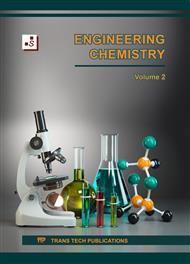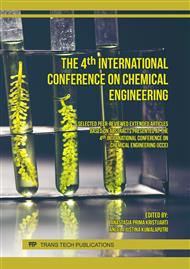[1]
Tim Satlak PI Ditjen Perkebunan, Pedoman Penerapan Sistem Pengendalian Intern (SPI). Jakarta: Direktorat Jenderal Perkebunan, 2017.
Google Scholar
[2]
E. Tuhumuri, R. P. Sancayaningsih, B. Setiaji, and S. Usman, "The implementation and effect of sasi on coconut (Cocos nucifera L.) harvest products in southern Buru, Indonesia," OCL J., vol. 27, no. 3, p.1–8, 2020.
DOI: 10.1051/ocl/2019053
Google Scholar
[3]
W. A. Rizal et al., "Chemical composition of liquid smoke from coconut shell waste produced by SME in Rongkop Gunungkidul," in Earth and Environmental Science, 2020, p.1–7.
DOI: 10.1088/1755-1315/462/1/012057
Google Scholar
[4]
Z. P. Gama, R. M. A. Purnama, and D. Melani, "High Potential of Liquid Smoke from Coconut Shell (Cocos nucifera) for Biological Control of Rice Bug (Leptocorisa oratorius Fabricius)," J. Trop. LIFE Sci., vol. 11, no. 1, p.85 – 91, 2021.
DOI: 10.11594/jtls.11.01.11
Google Scholar
[5]
R. Hadanu and D. A. N. Apituley, "Volatile Compounds Detected in Coconut Shell Liquid Smoke through Pyrolysis at a Fractioning Temperature of 350-420 C," Makara J. Sci., vol. 20, no. 3, p.95–100, 2016.
DOI: 10.7454/mss.v20i3.6239
Google Scholar
[6]
M. Jahiding et al., "Characterization of Coconut Shell Liquid Volatile Matter (CS-LVM) by Using Gas Chomatroghaphy," in The 5th International Conference on Theoretical and Applied Physics 2015, 2015, p.1–8.
DOI: 10.1088/1742-6596/846/1/012025
Google Scholar
[7]
H. Qi et al., "Mechanism of Magnetic Nanoparticle Enhanced Microwave Pyrolysis for Oily Sludge," Energies, vol. 15, no. 1254, p.1–23, 2022, doi: 10.3390/en15041254 10.3390/en15041254.
DOI: 10.3390/en15041254
Google Scholar
[8]
A. Khelfa, F. A. Rodrigues, M. Koubaa, and E. Vorobiev, "Microwave-Assisted Pyrolysis of Pine Wood Sawdust Mixed with Activated Carbon for Bio-Oil and Bio-Char Production," Processes, vol. 8, no. 1437, p.1–12, 2020.
DOI: 10.3390/pr8111437
Google Scholar
[9]
B. A. Mohamed, N. Ellis, C. S. Kim, and X. B, "Synergistic Effects of Catalyst Mixtures on Biomass Catalytic Pyrolysis," Front. Bioeng. Biotechnoligy, vol. 8, p.1–14, 2020.
DOI: 10.3389/fbioe.2020.615134
Google Scholar
[10]
R. Benavente, M. D. Salvador, A. Centeno, B. Alonso, A. Zurutuza, and A. Borrell, "Study of Microwave Heating Effect in the Behaviour of Graphene as Second Phase in Ceramic Composites," Materials (Basel)., vol. 13, p.2–11, 2020.
DOI: 10.3390/ma13051119
Google Scholar
[11]
I. Kalinke, P. Kubbutat, S. T. Dinani, S. Ambros, M. Ozcelik, and U. Kulozik, "Critical assessment of methods for measurement of temperature profiles and heat load history in microwave heating processes—A review," C O MPREH E NSIVE Rev. I N F OOD Sci. F OOD S A FE TY, vol. 21, p.2118–2148, 2022.
DOI: 10.1111/1541-4337.12940
Google Scholar
[12]
A. Kumar, S. Singh, and D. Singh, "Development of Double Layer Microwave Absorber Using Genetic Algorithm," in International Conference on Advanced Technologies in Design, Mechanical and Aeronautical Engineering, 2017, p.1–6.
Google Scholar
[13]
Wei Zuo, Y. Tian, and N. Ren, "The important role of microwave receptors in bio-fuel production by microwave-induced pyrolysis of sewage sludge," Waste Manag., vol. 31, p.1321–1326, 2011.
DOI: 10.1016/j.wasman.2011.02.001
Google Scholar
[14]
F. Mushtaq, T. A. T. Abdullah, R. Mat, and F. N. Ani, "Optimization and characterization of bio-oil produced by microwave assisted pyrolysis of oil palm shell waste biomass with microwave absorber," Bioresour. Technol., vol. 15, p.1–18, 2015.
DOI: 10.1016/j.biortech.2015.02.055
Google Scholar
[15]
J. N. BeMiller and K. C. Huber, "Physical Modification of Food Starch Functionalities," Annu. Rev. Food Sci. Technol, vol. 6, p.21.1-21.51, 2015.
DOI: 10.1146/annurev-food-022814-015552
Google Scholar
[16]
T. Fujii, A. Oshita, and K. Kashimura, "Behaviour of Microwave-Heated Al4SiC4 at 2.45 GHz," Materials (Basel)., vol. 14, no. 4878, p.1–9, 2021.
DOI: 10.3390/ma14174878
Google Scholar
[17]
M. dwi C. . Tantiana and I. Arundina, "Analgesic effect of coconut shell (Cocos nucifera L) liquid smoke on mice," Dent. J., vol. 45, no. 3, p.156–160, 2012.
DOI: 10.20473/j.djmkg.v45.i3.p156-160
Google Scholar



